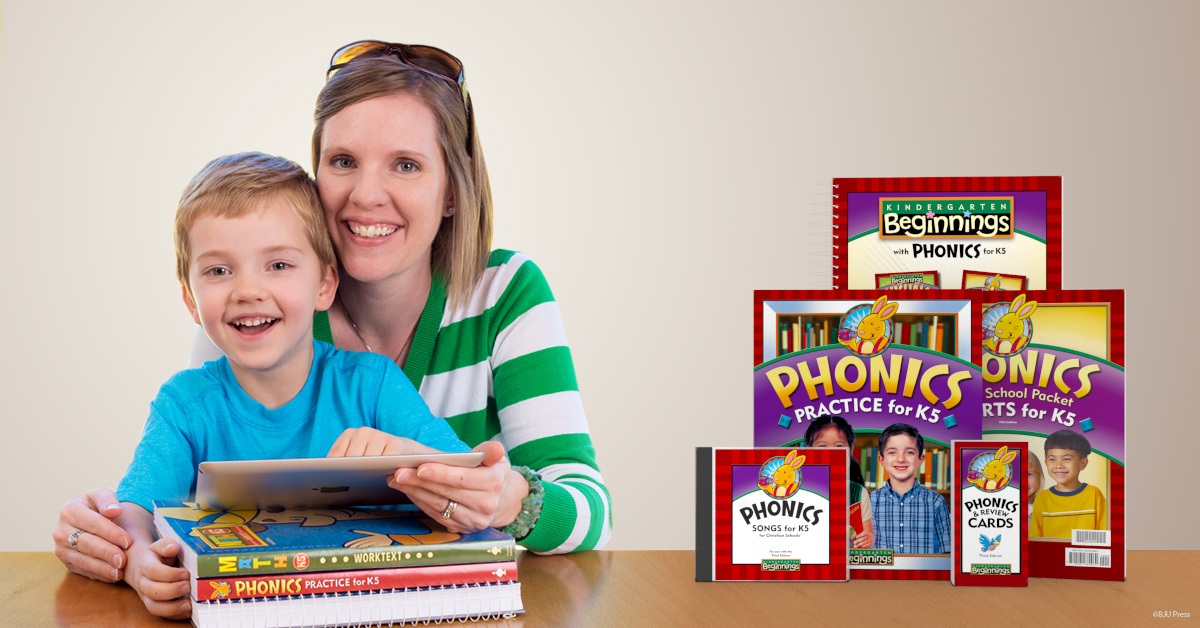
Before I learned how to read, I pretended to read books aloud. With some of my favorite picture books, I could quote the text by heart as I turned the pages. The actual process of reading was a lot harder than rote memorization—it involved forming connections, remembering patterns, applying principles, and a lot of phonics. I still remember the thrill as the pieces clicked into place, and suddenly I was reading for real.
Your child already knows how to speak English and understand it. Now, as a homeschool parent, it’s your job to teach him to read and write it well. As you prepare your child for success in reading, you have to start with what he knows—the sounds of language, or phonics.
Sights and Sounds
You may have begun teaching phonemic awareness earlier than K5. But if not, don’t worry. The BJU Press K5 Beginnings program will help your child learn to listen for specific sounds and connect those sounds with letters and letter combinations. Before long, your little one will begin to realize that the letters of the alphabet don’t just have names; they represent sounds. Combined together, those sounds can form words.
BJU Press curriculum emphasizes phonics as the basis for reading excellence, but the Beginnings program incorporates plenty of sight words as well. Learning these common, recognizable words helps kids move more quickly through a text and gives them a head start with building their vocabulary.
Exceptions and Rules
The English language is full of strange rules and odd exceptions that can be very confusing for kids who are just learning to read. If your child is struggling with remembering some of those rules and exceptions, it’s time to turn the lesson into a game.
Children love stories, so why not make phonics seem like a wonderful story filled with lovable characters? In the K5 Beginnings program, you’ll find Miss Silent E and Bossy R along with other characters who serve as guides for phonics comprehension. By lending personality and depth to these abstract concepts, the program helps children remember and apply them.
Memory Hacks
Songs are wonderful tools for remembering important facts and ideas, so the Beginnings program incorporates plenty of catchy tunes about phonics. You can use the phonics songs CD anytime to reinforce and enhance learning.
You can also hang up the provided charts displaying word-family rhymes, so your child has a clear reminder of those patterns. Word families are a major emphasis of the BJU Press phonics program, and with good reason! Knowing word families builds an excellent foundation for more accurate reading, whether the words are familiar or new.
Phonics Drills
In order for your kids to excel at phonics and reading, they must practice. The phrase “phonics drill” may not sound pleasant, but it can actually be an enjoyable experience for you and your kids. When you read sentences, your child can fill in the easy two- or three-letter words. Talk together about Mr. and Mrs. Short, who illustrate the rule that “a short vowel is always followed by a consonant or consonants.” You can look for Mr. and Mrs. Short, Miss Long, and the other phonics characters wherever you and your children are—at the grocery store, in the car, at the park, or on a walk through the neighborhood.
At first, the phonics drills will feel like a challenge; but before long, your kids will begin to realize how much of the world opens up to them when they remember their phonics word families and friends. And just like that, they’re reading.
Explore what you need to know about the K5 Beginnings program.
• • • • •
Rebecca is a work-at-home freelance writer, novelist, wife, and the mom of two bright-eyed little ones. She credits her success in writing and her love of books to her own mom, who homeschooled three kids from pre-K through high school.